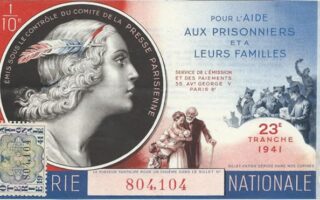Transcribing Life Through Art: Renoir, Father and Son

- SUBSCRIBE
- ALREADY SUBSCRIBED?
BECOME A BONJOUR PARIS MEMBER
Gain full access to our collection of over 5,000 articles and bring the City of Light into your life. Just 60 USD per year.
Find out why you should become a member here.
Sign in
Fill in your credentials below.
Illustrator Jak Lemonnier and writer Eddy Simon have combined forces to create a tender historical account of Renoir’s life and the story of his second son, film director Jean Renoir. The story revolves around the hours Jean spent with his father at Cagnes-sur-Mer while recuperating from injuries suffered in the Great War. The story spins off in different directions as father and son define themselves through their art. Both the artiste and the auteur sought to transcribe the spectacle of life through their art. We see a young man striking out to make his own mark in the world while his famous father is losing his potency.
Renoir: Father and Son is no comic book of yore. This is a kinder and gentler take on the graphic novel. Jak Lemonnier has created a stellar work of art in a format that old man Renoir and his son would have approved of. The introduction by Jacques Renoir – Renoir’s great grandson tells how he found his great-uncle’s stash of early 20th century bandes-dessinée, comic books, inside the family’s laundry-room closet.
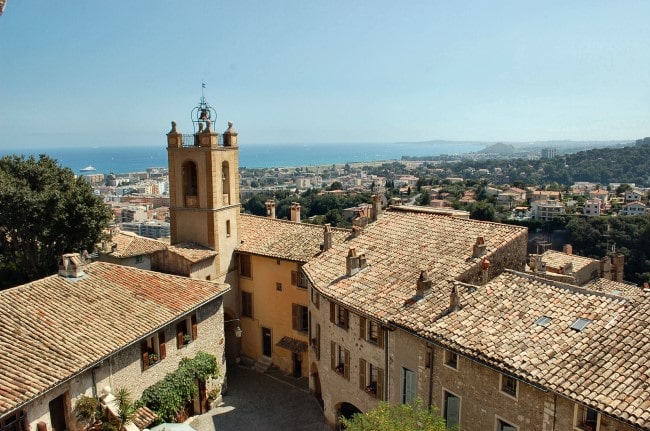
The old village of Haut-de-Cagnes as seen from the château. (C) CC BY-SA 3.0
Jacques Renoir accurately describes Eddy Simon’s work as well researched. Translated from French, lots of Gallic color remains in the subtly notated text to keep the story vibrant. At times the English translation leaves something to be desired. The occasional handwritten letter isn’t translated, but the bande-dessinée form can go above and beyond the language barrier. I have copies of Tintin, Leo Mallet’s Nestor Burma and Gradimir Smudja’s Vincent et Van Gogh in their original French because the meaningful tableaux and fleeting images tell the story in as few words as possible.

Auguste Renoir. (C) Public Domain
On Renoir’s easel Lemonnier’s cartoon art magically transforms into recognizable Renoir masterpieces, but in postage stamp size. Readers familiar with Renoir’s works will see many familiar paintings and montages. Others will quickly become acquainted with Renoir’s style and story.
The reader is in front of Auguste Renoir’s canvas and behind Jean Renoir’s camera. As Jean was raised at the knee of his artist father, some of his father’s influence would undoubtedly rub off. Renoir tells his little son to protect his hands and fingers are there are necessary for a tactile life. The irony here is that Renoir, as an elder father, ages rapidly as the ravages of arthritis cripple his fingers. Little Jean wants to be a painter like his father but Renoir is more philosophical. “Don’t force your hand,” he says to his son, “be a cork bobbing on a stream or a feather on the wind. Follow the current life sends you.” The cork motif is one that pops up throughout the panels of Renoir: Father and Son.

Renoir: Father and Son excerpt. (C) Jak Lemonnier and Eddy Simon
The story jumps to Renoir’s early days where, as the son of a tailor and a seamstress, he enjoyed working with his hands. Renoir had aspirations of bigger and better things, but he was one of the few Impressionists that wasn’t born with a silver spoon in his mouth. Again hands are a recurring theme. A page alludes to the fact that Renoir’s fingers may have become prone to arthritis due to the thwacks he received at the hand of the brother at his parochial school. Destined to work with his hands when he was young, Renoir’s hands failed him as he aged.
From Renoir sleeping on his father’s work bench to singing in the choir at Saint-Eustache, Simon and Lemonnier introduce readers to the young artist’s lesser known life and follow him to the ubiquitous Paris garret where he lived as a poor street artist. Cameos of the 19th-century painters Bazille, Monet, Sisley, Courbet, Cezanne and Caillebotte all show up here. Zola and Nadar show up amidst the usual suspects in the night cafes.
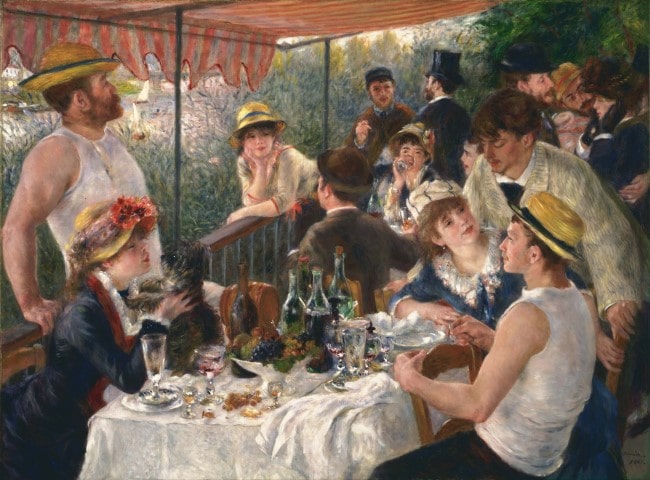
The Luncheon of the Boating Party. (C) Public Domain
The young model Aline Charigot, whom Renoir paints with her petit chien in The Luncheon of the Boating Party, is the keystone of the two biographies. Renoir’s long-time girlfriend and the mother of Renoir’s recognized children would become his wife. Renoir was 44 before he started his first legitimate family with Aline and Jean was born in 1894.
From the birth of Jean, the story jumps to 1915 with the bullet Jean takes in the First World War. The family apartment at Boulevard de Rochechouart contained a limping duo of father and son. Watching his father work as he was convalescing, Jean learned from his father and grew to understand him. Crippled with arthritis, Renoir still wanted to feel real world experiences and faced his easel everyday. Jean understood from his father what it was like to be totally absorbed in one’s passion.
Although Renoir isn’t painted or photographed as being especially jolly, Renoir was in effect a light-hearted man, popular wherever he went. Both sides of this Renoir story have a serious, melancholic tone. I think there was a lot of joy and whimsy in Renoir’s life which isn’t captured in Renoir: Father and Son. Painting was a joy to Renoir but his art tutor berated him for painting with too much joie de vivre, too much color. The Renoir brothers treated their father to his first experience of motion pictures – one of Charlie Chapin’s early films. The brothers agreed that their father had a very Chaplinesque side to him.
At this point in Renoir: Father and Son, Jean is acquainting his father to the fact that his artistic passion is film. Of Renoir’s many philosophies and bon mots, the one that stuck with Jean was he image that we are just corks floating in a stream: It helps to be a talented cork. Jean did everything he could to escape his father’s shadow but Renoir Senior’s aesthetic shone through. He had grown up around his paintings but also his philosophy.
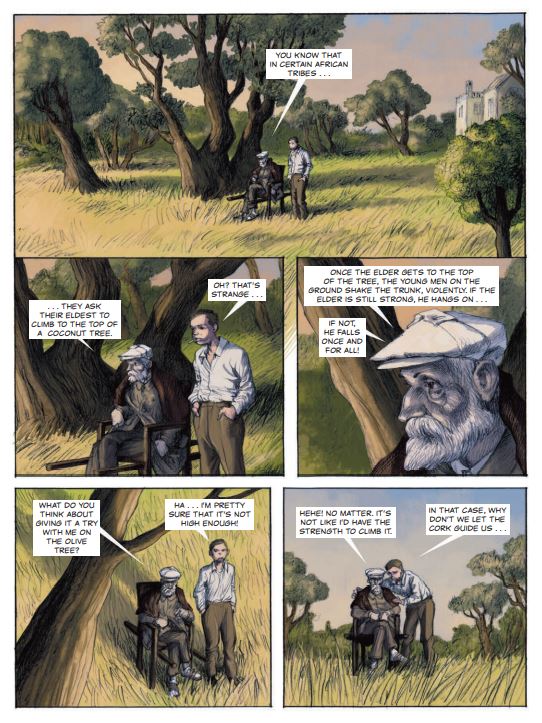
Renoir: Father and Son excerpt. (C) Jak Lemonnier and Eddy Simon
Like the beautiful 2012 film Renoir by director Gilles Bourdos, there is the suggestion of rivalry between the two Renoirs as one gathers strength and the other takes the back seat. Jean took Renoir’s last nude model Dedée for himself and married her in 1920. She would go on to be the star of Jean’s early movies and became a silent film icon.
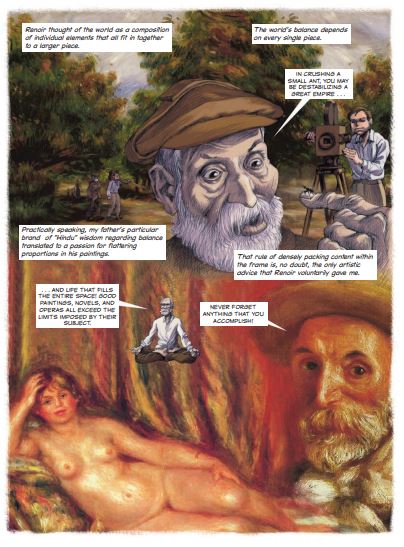
Renoir: Father and Son excerpt. (C) Jak Lemonnier and Eddy Simon
Jean Renoir built up his filmography: Boudou Saved from Drowning, Grande Illusion, Rules of the Game. Jean moved to Hollywood but found it hard to fit into the mould of American movies. He returned to France and to the subjects he knew – directing The French Cancan and Luncheon on the Grass, filmed at the old family estate. To quote Jean Renoir, he “stuffed himself with the Renoir aesthetic like subconscious faith.” Like his father Jean understood the joy and pain of artistic creation. In 1962 Jean Renoir wrote a memoir titled Renoir, My Father – this graphic novel, Renoir: Father and Son, could be a storyboard for that work. The creators acknowledge that pages from the chapter “Impression, Sunset” are taken verbatim from Jean’s biography.
The book ends with a chronology of both father and son, a select bibliography, and also cleverly lists how to follow in the footsteps of Renoir.
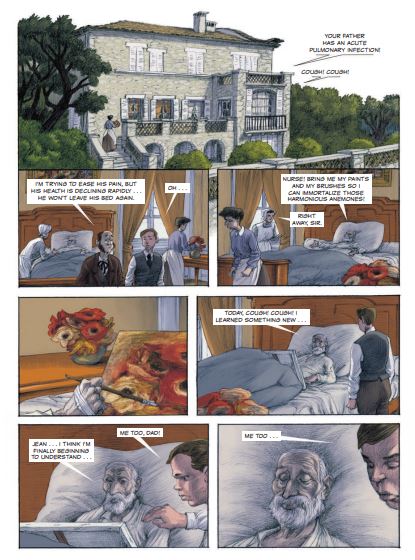
Renoir: Father and Son excerpt. (C) Jak Lemonnier and Eddy Simon
Simon and Lemonnier’s story is a great departure from the ubiquitous Marvel and DC adventures. Anyone who likes French culture would like this story, from comic readers to art historians, but in this day when homeschooling has come to the forefront, this is a painless way to introduce the history of art and cinema into to younger readers. I would like to see another dynamic duo of art history. The relationships between Cezanne and Zola, or Monet and Clemenceau would fit this formula.
Jak Lemonnier, a man with many pseudonyms, graduated from the École des Beaux Arts. This talented caricaturist is the illustrator of dozens of comics for younger kids, Leo and Lu and Robinson to name but a few.
Former journalist Eddy Simon is also the author of the graphic novel biographies of Gustave Eiffel, Pélé, Sarah Bernhardt, and Rodin. He is the creator of a series of bandes-dessinées in his adopted home of Pondicherry, India.
You can purchase Renoir: Father and Son on Amazon here.
Lead photo credit : "Renoir: Father and Son", illustrated by Jak Lemonnier and written by Eddy Simon
More in book review, Novel, poetry, Renoir, writers in Paris



